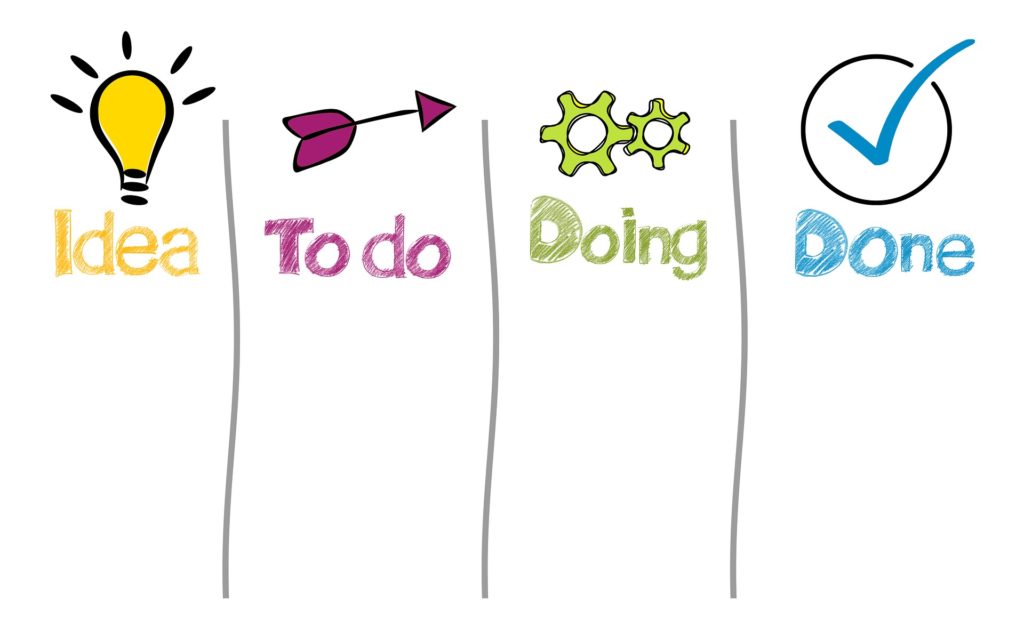Many of us rely on visual management without knowing what it is. One classic example is writing a reminder of something on a sticky note before putting it on someone’s desk or keyboard to make sure they prioritize it. Kanban boards can be seen as a form of business dashboard everyone in the organization can use to visually manage their work. In fact, their name derives from the Japanese term for “visual card”. And more people are realizing how Kanban could help them improve their processes and run their teams more efficiently. Here are four reasons your business needs to use Kanban boards.
It Is a Constant Reminder
One of the benefits of Kanban boards is that they are constant reminders of the state of the work. Everyone can see what hasn’t been started yet, which tasks are in progress, and which items were finished. This saves people from wasting time on projects that are completed or trying to take up tasks that have impediments in the way.
Looking up and seeing the status of items on the board reminds people what they need to be doing, as well as it improves their productivity. It also makes shift rotations easier and allows workers to pass on tasks fast and easily. Online tools even allow workers to see what tasks need to be done before they punch in, allowing them to prepare mentally and hit their shift in stride.
It Improves Communication
While Kanban boards do not eliminate the need for periodic status meetings, you do not need status reports. Just look at the Kanban board. Your Kanban board can indicate the impediments preventing tasks from moving forward. Those with the ability or authority know what they need to do and why. It gives everyone the ability to visualize processes and workflows, making sure everyone is on the same page. Another benefit of using Kanban boards is that they help teams self-manage.
You can take things to the next level with a Kanban board online. There are several reasons to use an online Kanban board. One is that physical Kanban boards can be difficult to organize. A digital one is simpler to maintain, and it will not take up any space.
Kanbanize is an example of a software that provides good digital Kanban board. Their tool can be accessed from anywhere by anyone with a good internet connection. Now a manager can check on the project status without having to go into the office or ask someone about the state of affairs. Team members can also update the board as they complete tasks, no matter where they are. Remote team members are working off the same information as everyone else, too.
In addition, team members at an organization are always aware of what needs to be done and what they are waiting for. They know which tasks are available for them to take up if they are qualified. Managers are still needed to provide resources, answer questions or help those who do not know what they can do. However, micromanagement is no longer necessary. When the boss does not have to wander around asking what people are doing, they can focus on the big picture and ask more questions that are important.
Introducing a Kanban system can empower your workforce. When your workers have more autonomy and more influence on the process, they become more involved in it. Eventually, this makes them more engaged in the workplace too. They feel as if they have a hand in the management process, which can be rewarding. On the other hand, the transparency that the system offers empowers management as well, allowing them to focus on meeting objectives instead of wasting time on detailed plans that could easily be derailed at any minute.
A side benefit of online Kanban tools is that you can also pull up historical information as required. The ability to monitor individual performance and average cycle time provides the information you need to gauge performance. This allows you to work on continuous improvement, which is what the whole Kanban method was built upon.
You Can Change Priorities Quickly
Perhaps the installation of a new production line or construction of a new building was your highest priority. Management decides that a retrofit or repairs are now your highest priority. A Kanban board allows you to quickly change the to-do list, metrics, and schedule for the entire group.
When you’re working on a software project, it is obvious that the new priority is fixing a newly discovered security hole than the upcoming software release. When you have to drop a requirement from your software development project or features from the new product release, it is moved off to the side. Your team won’t forget about it, but they will no longer waste time on what is no longer important. This is why Kanban boards are considered essential in agile workplaces.
You’ll Have Fewer and Shorter Meetings
One benefit of adopting Kanban boards is that you’ll have fewer meetings, and those that need to occur are much shorter. Meetings to discuss the change in priorities are probably necessary, but someone who returns from vacation a week later will know immediately that the original project is no longer the highest priority. You do not have to gather everyone together at the start of the week to keep them all informed.
If you do need to hold a meeting, it is to work out solutions to problems instead of discussing what each person is working on and the team’s plan for the next week. Planning will involve the overarching budget or discussion of how to cover someone on vacation, not delegating tasks for the day.
Conclusion
Kanban boards were credited for Japanese firms achieving amazing levels of quality and productivity. While technology is altering how everyone does their jobs, Kanban boards in all their forms remain an effective management tool. Make sure that you look into what they could do for your operation and make sure you get your whole team involved in the adoption process.



